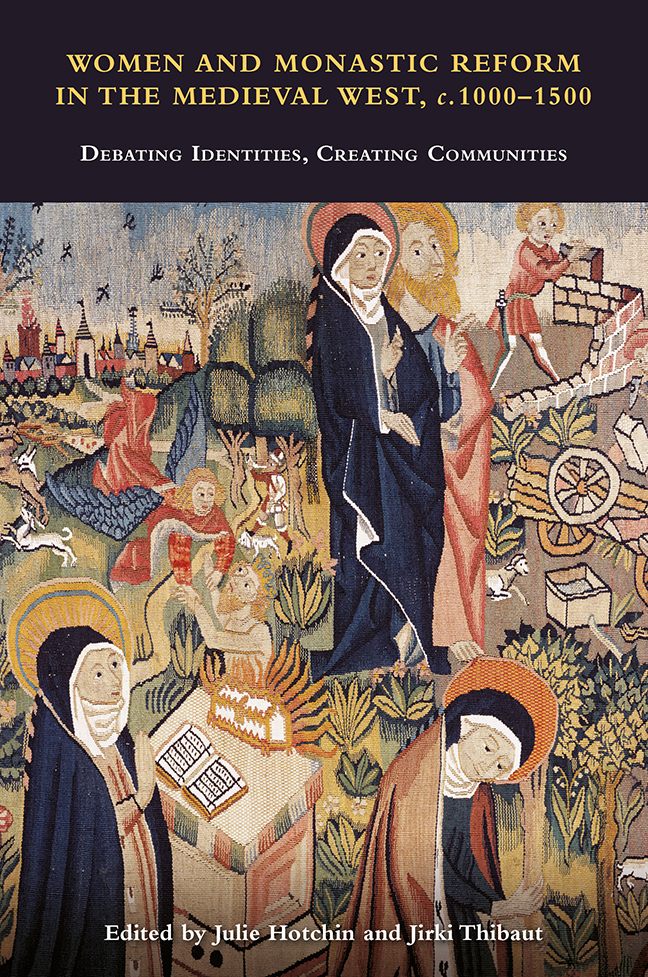 Women and Monastic Reform in the Medieval West, c.100-1500
Women and Monastic Reform in the Medieval West, c.100-1500 Book contents
- Frontmatter
- Dedication
- Contents
- List of Illustrations
- List of Contributors
- Acknowledgements
- List of Abbreviations
- 1 Debating Identities: Women and Monastic Reform in the Medieval West, c. 1000–1500
- 2 Liturgy and Female Monastic Hagiography Around the Year 1000: A lecture croisée of the Life of Liutrud, the Second Life of Glodesind of Metz and the So-called Pontificale Romano-Germanicum
- 3 Remakers of Reform: The Women Religious of Leominster and their Prayerbook
- 4 The Materiality of Female Religious Reform in Twelfth-Century Ireland: The Case of Co-located Religious Houses
- 5 Women as Witnesses: Picturing Gender and Spiritual Identity in a Twelfth-Century Embroidered Fragment from Northern Germany
- 6 Mulieres religiose and Cistercian Nuns in Northern Italy in the Thirteenth Century: A Choice of ‘Order’
- 7 Circulation of Books and Reform Ideas between Female Monasteries in Medieval Castile: From Twelfth-Century Cistercians to the Observant Reform
- 8 Women, Men and Local Monasticism in Late Medieval Bologna
- 9 Building Community: Material Concerns in the Fifteenth-Century Monastic Reform
- 10 Who Made Reform Visible? Male and Female Agency in Changing Visual Culture
- 11 Nuns, Cistercian Chant and Observant Reform in the Southern Low Countries
- Index
- Other volumes in Studies in the History of Medieval Religion
3 - Remakers of Reform: The Women Religious of Leominster and their Prayerbook
Published online by Cambridge University Press: 09 January 2024
- Frontmatter
- Dedication
- Contents
- List of Illustrations
- List of Contributors
- Acknowledgements
- List of Abbreviations
- 1 Debating Identities: Women and Monastic Reform in the Medieval West, c. 1000–1500
- 2 Liturgy and Female Monastic Hagiography Around the Year 1000: A lecture croisée of the Life of Liutrud, the Second Life of Glodesind of Metz and the So-called Pontificale Romano-Germanicum
- 3 Remakers of Reform: The Women Religious of Leominster and their Prayerbook
- 4 The Materiality of Female Religious Reform in Twelfth-Century Ireland: The Case of Co-located Religious Houses
- 5 Women as Witnesses: Picturing Gender and Spiritual Identity in a Twelfth-Century Embroidered Fragment from Northern Germany
- 6 Mulieres religiose and Cistercian Nuns in Northern Italy in the Thirteenth Century: A Choice of ‘Order’
- 7 Circulation of Books and Reform Ideas between Female Monasteries in Medieval Castile: From Twelfth-Century Cistercians to the Observant Reform
- 8 Women, Men and Local Monasticism in Late Medieval Bologna
- 9 Building Community: Material Concerns in the Fifteenth-Century Monastic Reform
- 10 Who Made Reform Visible? Male and Female Agency in Changing Visual Culture
- 11 Nuns, Cistercian Chant and Observant Reform in the Southern Low Countries
- Index
- Other volumes in Studies in the History of Medieval Religion
Summary
The Rule attributed to Benedict of Nursia (d. 547) was first brought to England at the end of the sixth century with the Roman mission led by Augustine, the first bishop of Canterbury (579–c. 509). Among the monastic communities that were founded in the ensuing three and a half centuries, however, adherence to the Rule was by no means universal or exclusive. It was not until the tenth century, when concerted efforts were made to revive monasticism in England, that the imposition of the Rule as the sole guide to monastic life on communities of both men and women religious became a desideratum. These efforts culminated in a council convened by King Edgar (959–75) at Winchester in c. 973. Led by Dunstan, archbishop of Canterbury (960–78), Athelwold, bishop of Winchester (963–84), and Oswald, both bishop of Worcester (961–92) and archbishop of York (971–92), the council promulgated an agreement that Athelwold had crafted: the Regularis concordia anglicae nationis monachorum sanctimonialiumque. Through this agreement, the council sought to unify the practices of monastic communities across England by placing them under the protection of the king and queen, and by standardizing liturgical practice and other aspects of daily life. The Benedictine Rule, decrees from the councils summoned by Louis the Pious at Aachen (814–40) in 816 and 817, the customaries of Fleury, Ghent and other northern continental monasteries, and some native traditions informed the agreement's composition.
In its proem, the Concordia addresses both monks and nuns, and recalls that abbots and abbesses attended the council at Winchester. Such explicit inclusivity of nuns in the text's opening moved Jean Leclercq to observe that ‘one of the most charming’ features of this reform effort was ‘the part played by women at all levels’; in his estimation, it was the characteristic that ‘distinguished the English reform from all others’. Thomas Symons thought it likely that members of the women's monastic communities at Nunnaminster, Shaftesbury and Wilton were in attendance at the council. Symons did not provide evidence to support his claim beyond citing the Concordia's proem, but the geographical locations of these communities – all in Wessex – and the manner in which they were founded – all by members of the royal house of Wessex – probably encouraged him to draw this conclusion.
- Type
- Chapter
- Information
- Women and Monastic Reform in the Medieval West, c.100-1500Debating Identities, Creating Communities, pp. 57 - 80Publisher: Boydell & BrewerPrint publication year: 2023


